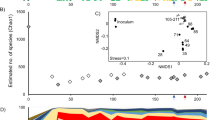Abstract
Arthrobacter sp. GLP-1 can utilize a wide range of organophosphonates as its sole source of phosphorus. The in-situ formation of sarcosine and methane from glyphosate and methanephosphonic acid respectively was studied. These two processes are differentially induced during phosphorus-deprivation. Methanephosphonic acid strongly inhibits glyphosate degradation (I50 10 μM), but glyphosate has very little effect on methane generation (I50 150 mM). The pattern of inhibition by other organophosphonates and organophosphonate analogues is also very different for the two systems. Degradation of glyphosate and methanephosphonic acid therefore represent distinct processes.
Similar content being viewed by others
Abbreviations
- f.wt.:
-
fresh weight
- MP-lyase:
-
methanephosphonate lyase
References
Amrhein N & Filner P (1973) cAMP in Chlamydomonas reinhardti: isolation and characterization. Proc. Nat. Acad. Sci. USA 70: 1099–1103
Avila LZ, Loo SH & Frost JW (1987) Chemical and mutagenic analysis of aminomethylphosphonate biodegradation. J. Am. Chem. Soc. 109: 6758–6764
Balthazor TM & Hallas LE (1986) Glyphosate-degrading microorganisms from industrial activated sludge. Appl. Env. Microbiol. 51: 432–434
Bradford MM (1976) A rapid and sensitive method for microgram protein quantitation. Anal. Biochem. 72: 248–254
Chen C, Ye Q, Zhu Z, Wanner BL & Walsh CT (1990) Molecular biology of carbon-phosphorous bond cleavage. Cloning and sequencing of the phn (psiD) genes involved in alkylphosphonate uptake and C-P lyase activity in Escherichia coli B. J. Biol. Chem. 265: 4461–4471
Cook AM, Daughton CG & Alexander M (1978) Phosphonate utilization by bacteria. J. Bacteriol. 133: 85–90
Cordeiro ML, Pompliano DL & Frost JW (1986) Degradation and detoxification of organophosphonates: Cleavage of the carbon to phosphorus bond. J. Am. Chem. Soc. 108: 332–334
Frost JW, Loo S, Cordeiro ML & Li D (1987) Radical-based dephosphorylation and organophosphate biodegradation. J. Am. Chem. Soc. 109: 2166–2171
Hilderbrand RL (1983) Foreword. In: Hilderbrand RL (Ed) The Role of Phosphonates in Living Systems. CRC Press, Boca Raton, Florida. 2–3
Horiguchi M (1984) Chemistry of phosphonic and phosphinic acids. In: Hori T, Horiguchi M & Hayashi A (Eds) Biochemistry of Natural C-P Compounds. Maruzen, Kyoto. 8–22
Horiguchi M & Kandatsu M (1959) Isolation of 2-aminoethane-phosphonic acid from rumen protozoa. Nature (London) 184: 901–902
Kishore GM & Jacob GS (1987) Degradation of glyphosate by Pseudomonas sp. PG2982 via a sarcosine intermediate. J. Biol. Chem. 262: 12164–12168
LaNauze JM, Coggins JR & Dixon HBF (1977) Aldolase-like imine formation in the mechanism of action of phosphono-acetaldehyde hydrolase. Biochem. J. 165: 409–411
LaNauze JM, Rosenberg H & Shaw D (1970) The enzymic cleavage of the carbon-phosphorus bond. Purification and properties of phosphonatase. Biochim. Biophys. Acta 212: 332–350
Lanzetta PA, Alvarez LJ, Reinach PS & Candia DA (1979) An improved assay for nanomole amounts of inorganic phosphate. Anal. Biochem. 100: 95–97
Moore IK, Braymer HD & Larson AD (1983) Isolation of a Pseudomonas sp. which utilizes the phosphonate herbicide glyphosate. Appl. Env. Microbiol. 46: 316–320
Murata K, Higaki N & Kimura A (1988) Detection of carbonphosphorus lyase activity in cell free extracts of Enterobacter aerogenes. Biochem. Biophys. Res. Commun. 157: 190–195
Murata K, Higaki N & Kimura A (1989) A microbial carbonphosphorus bond cleavage enzyme requires two protein components for activity. J. Bacteriol. 171: 4504–4506
Pipke R & Amrhein N (1988a) Degradation of the phosphonate herbicide glyphosate by Arthrobacter atrocyaneus ATCC 13752. Appl. Env. Microbiol. 54: 1293–1296
Pipke R & Amrhein N (1988b) Carbon-phosphorus lyase activity in permeabilized cells of Arthrobacter sp. GLP-1. FEBS Lett. 236: 135–138
Pipke R, Amrhein N, Jacob GS, Schaefer J & Kishore GM (1987a) Metabolism of glyphosate in an Arthrobacter sp. GLP-1. Eur. J. Biochem. 165: 267–273
Pipke R, Schulz A & Amrhein N (1987b) Uptake of glyphosate by an Arthrobacter sp. Appl. Env. Microbiol. 53: 974–978
Quinn JP, Peden JMM & Dick RE (1989) Carbon-phosphorus bond cleavage by Gram-positive and Gram-negative soil bacteria. Appl. Microbiol. Biotechnol. 31: 283–287
Schowanek D & Verstraete W (1990) Phosphonate utilization by bacterial cultures and enrichments from environmental samples. Appl. Env. Microbiol. 56: 895–903
Shames SL, Wackett LP, Labarge MS, Kuczkowski RL & Walsh CT (1987) Fragmentative and stereochemical isomerization probes for homolytic carbon to phosphorus bond scission catalyzed by bacterial carbon-phosphorus lyase. Bioorg. Chem. 15: 366–373
Shinabarger DL & Braymer HD (1986) Glyphosate catabolism by Pseudomonas sp. strain PG2982. J. Bacteriol. 168: 702–707
Shinabarger DL, Schmitt EK, Braymer HD & Larson AD (1984) Phosphonate utilization by the glyphosate-degrading Pseudomonas sp. strain PG2982. Appl. Env. Microbiol. 4: 1049–1050
Talbot HW, Lohnson LM & Munnecke DM (1984) Glyphosate utilization by Pseudomonas sp. and Alcaligenes sp. isolated from environmental sources. Curr. Microbiol. 10: 255–260
Wacket LP, Shames SL, Venditti CP & Walsh CT (1987) Bacterial carbon-phosphorus lyase: products, rates and regulation of phosphonic and phosphinic acid metabolism. J. Bacteriol. 19: 710–717
Wanner BL (1987) Phosphate regulation of gene expression in Escherichia coli. In: Neidhart FC (Ed) Escherichia coli and Salmonella typhimurium Cellular and Molecular Biology, Vol 2 (pp 1326–1333). ASM, Washington
Wanner BL & Boline JA (1990) Mapping and molecular cloning of the phn (psiD) locus for phosphonate utilization in Escherichia coli. J. Bacteriol. 172: 1186–1196
Winkler KC & DeHaan PG (1948) On the action of sulfanilamide XII. A set of non-competitive sulfanilamide antagonists for Escherichia coli. Arch. Biochem. 18: 97–107
Author information
Authors and Affiliations
Rights and permissions
About this article
Cite this article
Kertesz, M., Elgorriaga, A. & Amrhein, N. Evidence for two distinct phosphonate-degrading enzymes (C-P lyases) in Arthrobacter sp. GLP-1. Biodegradation 2, 53–59 (1991). https://doi.org/10.1007/BF00122425
Received:
Accepted:
Issue Date:
DOI: https://doi.org/10.1007/BF00122425




